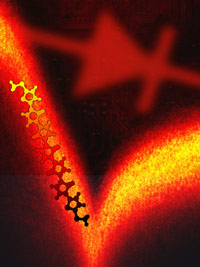
A collaborative team of researchers, including Foundry Director Jeff Neaton, have designed a new technique to create single-molecule diodes that perform 50 times better than all prior designs.
With electronic devices becoming smaller every day, the field of molecular electronics has become ever more critical in solving the problem of further miniaturization, and single molecules represent the limit of miniaturization. The idea of creating a single-molecule diode was suggested by Arieh Aviram and Mark Ratner who theorized in 1974 that a molecule could act as a rectifier, a one-way conductor of electric current. Researchers have since been exploring the charge-transport properties of molecules. They have shown that single-molecules attached to metal electrodes (single-molecule junctions) can be made to act as a variety of circuit elements, including resistors, switches, transistors, and, indeed, diodes. They have learned that it is possible to see quantum mechanical effects, such as interference, manifest in the conductance properties of molecular junctions.
Since a diode acts as an electricity valve, its structure needs to be asymmetric so that electricity flowing in one direction experiences a different environment than electricity flowing in the other direction. In order to develop a single-molecule diode, researchers have simply designed molecules that have asymmetric structures. In the past, asymmetric molecular designs have suffered from very low current flow in both ‘on’ and ‘off’ directions, and the ratio of current flow in the two has typically been low.
In order to overcome the issues associated with asymmetric molecular design, the team focused on developing an asymmetry in the environment around the molecular junction. They created an environmental asymmetry through a rather simple method—they surrounded the active molecule with an ionic solution and used gold metal electrodes of different sizes to contact the molecule.
Their results achieved rectification ratios as high as 250:50 times higher than earlier designs. And, because this new technique is so easily implemented, it can be applied to all nanoscale devices of all types, including those that are made with graphene electrodes. The next step is to develop an understanding the fundamental physics behind their discovery, and try to increase the rectification ratios they observed, using new molecular systems.

